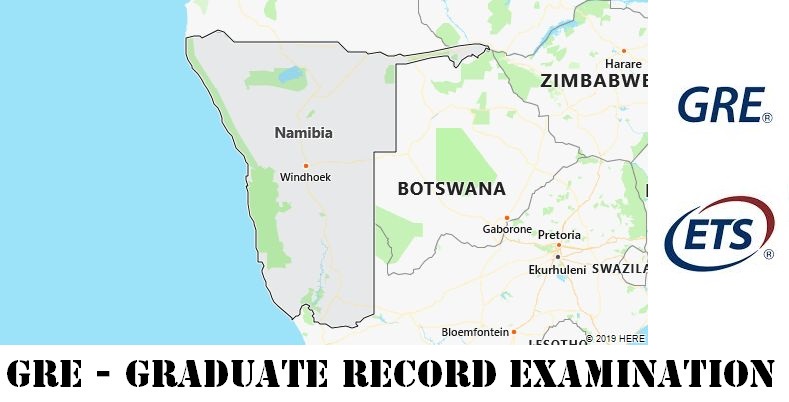GRE Testing Locations
Decided to take GRE exam? Now it is time to determine where to take the test. This site provides a full list of GRE testing centers in Namibia, among which, you can choose one that is nearest to you. Good news is that the following GRE test locations in Namibia offer both GRE general test and the GRE subject tests.

- TUCSIN High School – STN14225A
16 Mont Blanc Street, Eros, Windhoek
Namibia 9000
Computer Based Test
GRE Test Dates
There are two types of test format offered by the test maker – ETS: Computer-delivered and Paper-delivered GRE general tests. For computer based test format, the GRE General Test is offered year-round on a continuous basis, and available for registration on a first-come, first-served basis. For paper based general test, testing is available three times per year. The following test dates apply:
| Test Dates for Paper Based | Deadlines for Registration | Scores Available |
|---|---|---|
| November 09, 2019 | October 4, 2019 | December 20, 2019 |
| February 1, 2020 | December 27, 2019 | March 13, 2020 |
GRE Subject Tests in Namibia
The GRE Subject Tests are available on paper based only. In all GRE test centers throughout the world (both inside and outside United States), the exam is available three times a year. The three test dates are:
- April
- September
- October

More about Namibia
Namibia, officially English Republic of Namibia [ r ɪ p ʌ Republic ɔ v nə m ɪ biə ] German Republic of Namibia, country in southern Africa on the Atlantic Ocean with (2018) 2.4 million residents; The capital is Windhoek.
Population
The population is made up of different ethnic groups. The largest proportion have Bantu peoples, including the Ambo (47%) in the north (Ovamboland), the neighboring Kavango (9%) and the Herero (7%) in the Kaokoveld, Hereroland and in the center of the country. Tswana live in the east (around 0.5%). Other minorities are the San (around 2%); they are considered to be the indigenous population of Namibia and live mainly in the Sandveld (Kalahari).
The Nama (4.5%) belonging to the Khoikhoin live in Namaland in the south on sheep and goat farming. The Nama language is also spoken by the Mountain Dama (Damara) in the central northwest (Damaraland). The white population (6%) has 60% Afrikaans, 32% German and 8% English as their mother tongue. The Rehoboth Baster (about 2%), the descendants of Nama women and Boer immigrants from the South African Cape Province, who settled in Rehoboth south of Windhoek around 1870, are a separate people.
With only 3 residents / km 2, Namibia is extremely sparsely populated. Four fifths of the population live in the northern half of the country; large areas of the country are uninhabited. The proportion of the urban population is 49%. The biggest cities are Windhoek, Rundu and Walvis Bay.
Social: Central problems of the country are the unequal distribution of wealth, the high unemployment and the widespread poverty of the non-white majority of the population as well as the wide spread of the immune deficiency disease AIDS. The infection rate in adults (age group 15 to 49 years) is 13.8%.
The biggest cities in Namibia
| Biggest Cities (Residents 2011) | |
| Windhoek | 325 900 |
| Rundu | 63 400 |
| Walvis Bay | 62 100 |
| Swakopmund | 44 700 |
| Oshakati | 36 500 |
Religion
The Constitution (Article 21) guarantees freedom of religion; all religious communities are legally equal. Since there are no official statistics on religious affiliation, estimates from other institutions must be used. According to this, about 97% of the population are Christians: The majority of them belong to (post-) Reformation religious communities (predominantly Lutherans with about 50% of the population as well as Reformed, Methodists, Baptists, etc.), as well as about 20% of the Catholic Church and about 3% of the Anglican ones Church; there are also around 100 independent Christian churches or religious groups with references to the Bible ( Adventists, Mormons ). Namibia is the only state in Africa with an Evangelical Lutheran majority. The country’s three Lutheran churches, to which almost half of the population belong, have been working together since 2007 in the “United Church Council of the Evangelical Lutheran Churches of Namibia”. The Catholic ecclesiastical province established for Namibia in 1994 includes the Archdiocese of Windhoek with the suffragan diocese of Keetmanshoop and the Apostolic Vicariate of Rundu. The Anglican Diocese of Namibia (seat: Windhoek) is part of the Anglican Church of the Province of South Africa.
The Baha’is and Jews are very small religious minorities. The Jewish community founded by Jewish merchants from Cape Town in the middle of the 19th century has less than 100 members (synagogue in Windhoek). The number of Muslims living in the country is given as between 1 and 3%. Indigenous African religious practices are particularly widespread among the San and in the Kaokoveld among the Herero-belonging Himba and Tjimba and are mixed with Christian rites.
Windhoek
Windhoek (Afrikaans Windhoek), capital of Namibia, located in the center of the country, with (2011) 325,900 residents.
The buildings from the German colonial era include: built in Art Nouveau style and in its own veranda style.
From 1891 to 1919 Windhoek was the capital of German South West Africa, and in 1990 it became the capital of Namibia. Strong expansion of the city since the late 1980s.
